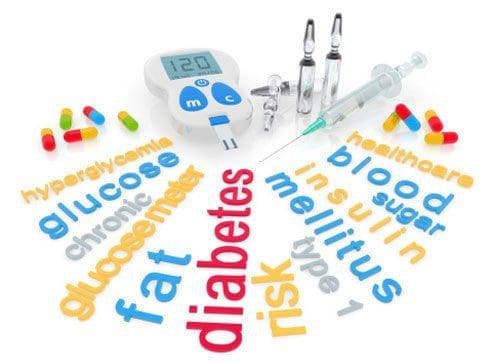Being overweight or obese is assumed to be the primary factor for people to develop type 2 diabetes. Excess weight is generally associated with insulin resistance and diabetes, however, it’s this insulin resistance, not the excess weight, which can cause the disease to develop.
Because of this, many individual’s who maintain a healthy weight may not necessarily be metabolically healthy, which can in turn increase the risk of diseases, such as type 2 diabetes, regardless if they’re overweight or obese. According to researchers from the University of Florida, one of the greatest risk factors for developing type 2 diabetes is actually inactivity, which can increase the risk or pre-diabetes even if you have a healthy weight.
Table of Contents
Inactivity and Pre-diabetes
If you were looking for motivation to get moving, this study, published in the American Journal of Preventive Medicine, is as good as it gets.1
In a research study published in the American Journal of Preventive Medicine, a survey of more than 1,100 healthy-weight individuals, those who were inactive, or physically active for less than 30 minutes per week, were more likely to score an A1C test level of 5.7 or higher, which is considered to be pre-diabetic.
The researchers suggested that people who live a sedentary lifestyle yet have a healthy weight may have  what is referred to as normal-weight obesity or skinny fat, which they described as a high proportion of fat to lean muscle.
“Don’t focus solely on the scale and think you’re OK. If you have a sedentary lifestyle, make sure you get up and move,†lead author Arch Mainous III, chair of health services research, management and policy in the University of Florida’s College of Public Health and Health Professions, stated in a news release of the subject matter.
Weight May Not Reveal a Person’s Metabolic Health
Dr. Robert Lustig, professor of pediatric endocrinology at the University of California, San Francisco, USCF, explains that weight isn’t necessarily an accurate tool to determine a person’s metabolic health. Dr. Lustig is best known for speaking out about the health risks of sugar. In a 2015 interview, he declared the issue of “judging a book by its cover” in terms of weight and health.
Approximately more than two-thirds of the American population is overweight or obese. About 50 percent have pre-diabetes or diabete and 1 out of every 3 have high blood pressure. Many of these individuals additionally have high serum triglycerides, which can be a huge factor when it comes to heart disease and stroke. Insulin resistance is a component of all of these health issues. According to Dr. Robert Lustig, at least 50 percent of the American population has some form of insulin resistance, regardless if they have an excess of weight or not.
Exercise is Essential to Prevent Diabetes
A variety of research studies and other evidence have concluded that regular participation and engagement in exercise and physical activity, which includes reducing time being spent sitting, can be crucial to help lower an individual’s risk of developing diabetes. Exercise can even help treat the disease once you’ve been diagnosed.
Sitting for more than eight hours a day has been shown to increase the risk of developing type 2 diabetes by up to 90 percent, while people with diabetes who participated in a six-month moderate-intensity exercise program experienced considerable health improvements, including decreased fat in the abdomen, liver and around the heart.
How to Determine if You’re Pre-Diabetic
If you’re uncertain on what your fasting insulin and glucose levels are to determine if you’re pre-diabetic, there are various blood tests which are recommended to receive annually. The fasting insulin level reflects how healthy a person’s blood glucose levels are over time.
A normal fasting blood insulin level is below 5, but ideally, you will want it to read below 3. A fasting glucose level below 100 mg/dl suggests you’re not insulin resistant while a level between 100 and 125 confirms you may have pre-diabetes. If these results, or your A1C level, confirms you either have or are at risk of pre-diabetes or diabetes, its fundamental for you to take action. Furthermore, a hip-to-waist size index chart can also be helpful to help determine the proper diagnosis for pre-diabetes or diabetes.
When it comes to evaluating whether the individual is overweight or obese, the previous tests may be better than utilizing the body mass index method, or BMI, as this test fails to factor in both how much muscle and intra-abdominal fat mass, or the visceral fat that accumulates around the inner organs, an individual may have. These can be indicators of insulin/leptin sensitivity and other associated health problems.
Insulin Sensitivity Improvements in Two Weeks
Fortunately, with proper exercise and a carefully balanced diet, people can reverse the course of type 2 diabetes. These benefits have been documented in as little as two weeks, in some instances, occurring just after one exercise session. During a research study for example, inactive but healthy middle-aged adults improved their insulin sensitivity and regulated their blood sugar over two weeks of interval training, about three sessions per week. A follow-up study also found that interval training positively impacted insulin sensitivity.
The research study was conducted involving people with type 2 diabetes and after only one interval training session, the individuals experienced an improvement in the regulation of their blood sugar for the following 24 hours. By exercising in short, high-intensity bursts, known as intervals, you can exercise for longer periods of time at a slower, steady pace and still experience the benefits. A recommended high-intensity interval training, or HIIT, approach is the Peak Fitness method, which consists of 30 secons of maximum effort followed by 90 seconds of recuperation, for a total of eight repetitions. Very slow weight lifting for your resistance training is also recommended.
Standing Up From Sitting is Also Essential
Moreover, it’s important to understand that exercising for 20 or 30 minutes a day but sitting for the rest is not enough physical activity to begin categorizing yourself as an active individual. In fact, sitting for an extended period of time has been linked to the development of chronic diseases such as diabetes, primarily because it can increase aging at a cellular level.
In a research study involving women ranging from 64 to 95 years of age, those who were sedentary and sat for more than 10 hours a day who engaged in only 40 minutes of moderate to vigorous exercise experienced shorter telomeres. In addition, the sedentary women were biologically about 8 years older than the active women in the research study.
The telomeres are utilized to measure biological aging because every time a cell divides, these become shorter. Shorter telomeres have also been associated with other chronic diseases, such as cancer, heart disease and diabetes.
Furthermore, the body’s ability to properly respond to insulin can be tremendously affected by only a single day of excessive inactivity. Sitting for extended periods of time can cause the pancreas to produce increased amounts of insulin. A research study published in Diabetologia, found that individuals who sat for long periods of time were twice as likely to develop diabetes of heart disease compared to individuals who sat for short periods of time. It’s recommended to replace the majority of your sitting with exercise or physical activity, keeping sedentary habits to three hours a day or less.
What to Do if You Have Pre-Diabetes or Diabetes
Being thin doesn’t necesarily mean you have more lean muscle than fat in your body. Having a higher percentage of fat than lean muscle can set the stage for insulin resistance. It’s not as simple to assume you’re metabolically healthy just because you’re not overweight or obese, especially if you live a sedentary lifestyle. Thin people who are also sedentary have as much risk of developing type 2 diabetes as someone who has excess weight.
The good news is, there’s plenty you can do to not only reduce your risk of developing type 2 diabetes and pre-diabetes but also to improve your metabolic health at the same time.
During the three-year Diabetes Prevention Program study, lifestyle interventions were found to be more effective than the diabetes drug Metformin at preventing or delaying the development of the disease in people at higher risk. A follow-up research study monitored the group for 15 years and lifestyle interventions were still more effective than Metformin at preventing diabetes.
One of the most important dietary recommendations is to limit net carbs, or total carbohydrates minus fiber, and protein, replacing them with higher amounts of high-quality healthy fats, such as seeds, nuts, raw grass-fed butter, olives, avocado, coconut oil, organic pastured eggs and animal fats, including animal-based omega-3s.
If you’re insulin resistant or diabetic, its also suggested that you limit your total fructose intake to 15 grams per day until your insulin/leptin resistance has improved, increasing to 25 grams, and then begin intermittent fasting as soon as possible.
In conclusion, exercise and physical activity while reducing the amount of time spent sitting, together with a balanced diet, including optimized levels of vitamin D and gut health, as well as proper sleep, are crucial towards preventing or improving type 2 diabetes and pre-diabetes. Taken together, this plan will  also substantially lower your risk of diabetes and related chronic diseases, helping you to avoid becoming victim to a health condition you might not even realize you have.
For more information, please feel free to ask Dr. Jimenez or contact us at 915-850-0900 .
By Dr. Alex Jimenez
Additional Topics: Neck Pain and Auto Injury
Neck pain is characterized as the most prevalent symptom after being involved in an automobile accident. During an auto collision, the body is exposed to a sheer amount of force due to the high speed impact, causing the head and neck to jolt abruptly back-and-forth as the rest of the body remains in place. This often results in the damage or injury of the cervical spine and its surrounding tissues, leading to neck pain and other common symptoms associated with whiplash-related disorders.
.video-containerposition: relative; padding-bottom: 63%; padding-top: 35px; height: 0; overflow: hidden;.video-container iframeposition: absolute; top:0; left: 0; width: 100%; height: 100%; border: none; max-width:100%!important;
TRENDING TOPIC: EXTRA EXTRA: New PUSH 24/7Â®ï¸ Fitness Center
Post Disclaimer
Professional Scope of Practice *
The information herein on "Slim Adults Can Also be at Risk of Developing Diabetes" is not intended to replace a one-on-one relationship with a qualified health care professional or licensed physician and is not medical advice. We encourage you to make healthcare decisions based on your research and partnership with a qualified healthcare professional.
Blog Information & Scope Discussions
Welcome to El Paso's Premier Wellness, Personal Injury Care Clinic & Wellness Blog, where Dr. Alex Jimenez, DC, FNP-C, a Multi-State board-certified Family Practice Nurse Practitioner (FNP-BC) and Chiropractor (DC), presents insights on how our multidisciplinary team is dedicated to holistic healing and personalized care. Our practice aligns with evidence-based treatment protocols inspired by integrative medicine principles, similar to those found on this site and our family practice-based chiromed.com site, focusing on restoring health naturally for patients of all ages.
Our areas of multidisciplinary practice include Wellness & Nutrition, Chronic Pain, Personal Injury, Auto Accident Care, Work Injuries, Back Injury, Low Back Pain, Neck Pain, Migraine Headaches, Sports Injuries, Severe Sciatica, Scoliosis, Complex Herniated Discs, Fibromyalgia, Chronic Pain, Complex Injuries, Stress Management, Functional Medicine Treatments, and in-scope care protocols.
Our information scope is multidisciplinary, focusing on musculoskeletal and physical medicine, wellness, contributing etiological viscerosomatic disturbances within clinical presentations, associated somato-visceral reflex clinical dynamics, subluxation complexes, sensitive health issues, and functional medicine articles, topics, and discussions.
We provide and present clinical collaboration with specialists from various disciplines. Each specialist is governed by their professional scope of practice and their jurisdiction of licensure. We use functional health & wellness protocols to treat and support care for musculoskeletal injuries or disorders.
Our videos, posts, topics, and insights address clinical matters and issues that are directly or indirectly related to our clinical scope of practice.
Our office has made a reasonable effort to provide supportive citations and has identified relevant research studies that support our posts. We provide copies of supporting research studies upon request to regulatory boards and the public.
We understand that we cover matters that require an additional explanation of how they may assist in a particular care plan or treatment protocol; therefore, to discuss the subject matter above further, please feel free to ask Dr. Alex Jimenez, DC, APRN, FNP-BC, or contact us at 915-850-0900.
We are here to help you and your family.
Blessings
Dr. Alex Jimenez DC, MSACP, APRN, FNP-BC*, CCST, IFMCP, CFMP, ATN
email: coach@elpasofunctionalmedicine.com
Multidisciplinary Licensing & Board Certifications:
Licensed as a Doctor of Chiropractic (DC) in Texas & New Mexico*
Texas DC License #: TX5807, Verified: TX5807
New Mexico DC License #: NM-DC2182, Verified: NM-DC2182
Multi-State Advanced Practice Registered Nurse (APRN*) in Texas & Multi-States
Multistate Compact APRN License by Endorsement (42 States)
Texas APRN License #: 1191402, Verified: 1191402 *
Florida APRN License #: 11043890, Verified: APRN11043890 *
License Verification Link: Nursys License Verifier
* Prescriptive Authority Authorized
ANCC FNP-BC: Board Certified Nurse Practitioner*
Compact Status: Multi-State License: Authorized to Practice in 40 States*
Graduate with Honors: ICHS: MSN-FNP (Family Nurse Practitioner Program)
Degree Granted. Master's in Family Practice MSN Diploma (Cum Laude)
Dr. Alex Jimenez, DC, APRN, FNP-BC*, CFMP, IFMCP, ATN, CCST
My Digital Business Card
RN: Registered Nurse
APRNP: Advanced Practice Registered Nurse
FNP: Family Practice Specialization
DC: Doctor of Chiropractic
CFMP: Certified Functional Medicine Provider
MSN-FNP: Master of Science in Family Practice Medicine
MSACP: Master of Science in Advanced Clinical Practice
IFMCP: Institute of Functional Medicine
CCST: Certified Chiropractic Spinal Trauma
ATN: Advanced Translational Neutrogenomics







 Again, We Welcome You.
Again, We Welcome You.
Comments are closed.